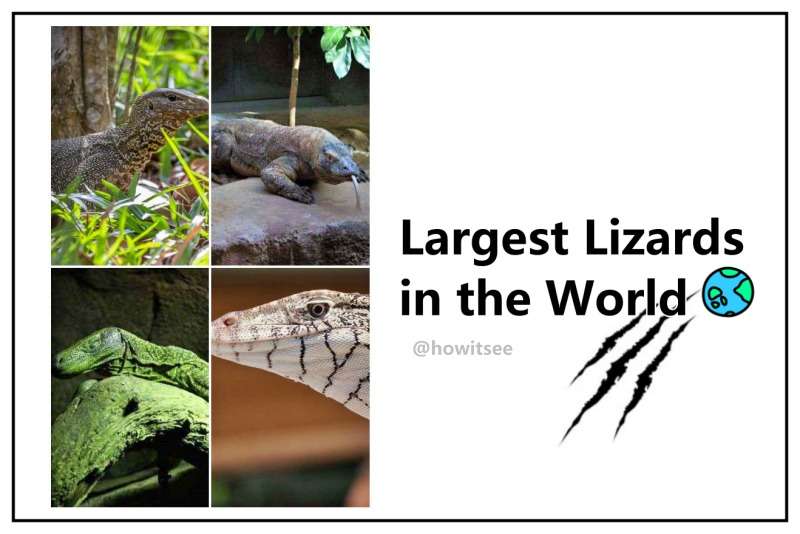This blog post focuses on Largest Lizards in the World Lizards are reptiles that consist of the maximum number of species, with 4,300 species of lizards present throughout the world.
Lizards come in all shapes and sizes, and the majority of species are small, though all of them share some common physical features such as clawed feet, dry and rough scaly skin, external ear openings, etc.
Though most lizards have four legs, some legless lizards exist and are included in this list. Moreover, besides having these features, all lizards have the unique feature of a fragile tail that they can regenerate and break off to confuse their predators.
They are cold-blooded reptiles and maybe venomous sometimes. Lizards are found in a variety of areas, such as tropical, subtropical, and temperate regions, inhabiting terrestrial, sub-arid, arboreal, and semi-aquatic habitats.
Feeding habits of lizards also vary greatly, and in terms of coloration, they are spectacular. They show and display a wide variety of brilliant colors, from sandy brown to bold orange, green, blue, and others.
Lizards are also beneficial to humans in many ways, such as controlling pests and various types of insects by halting them in backyards or gardens.
Lastly, a very important thing to mention is that they have the power to camouflage, which we have discussed in another blog post, which you can check here.
Top 30+ Largest Lizards in the World
31) La Gomera giant lizard
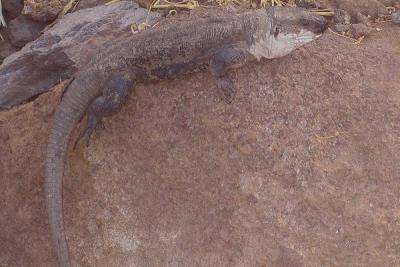
|
Scientific Name |
Gallotia bravoana |
|
Size |
up to 50 cm |
|
Life span |
No Information |
|
Location |
Parque Rural de Valle Gran Rey |
|
Diet |
herbivorous, insects |
Let’s begin the list of the largest lizards in the world with La Gomera giant lizard, which can grow up to half a meter from head to tail. The conservation status of these lizards is “Critically Endangered” due to overgrazing and hunting.
These lizards are diurnal, which means they carry out most of their activities during the day and predominately feed on plants. The body contrast of La Gomera giant lizard is in dark-brown color with dark patches.
30) Gila Monster

|
Scientific Name |
Heloderma suspectum |
|
Size |
56 cm (22 in) |
|
Life span |
20–36 years |
|
Location |
the northwestern Mexican state of Sonora and the southwestern United States. |
|
Diet |
Invertebrates, insects, frogs, lizards, small birds, and small mammals |
Gila Monsters are one of the largest venomous lizards and are named after the Gila River Basin.
Striking features about them are the presence of bead-like scales, which give them a dotted appearance, and the pink blotches on them.
They are nocturnal lizards that have fat tails because of the deposition of fat tissues within them.
They transfer venom through their big heads and muscular jaws, but their venom is not fatal to humans, and minor systemic symptoms may develop.
29) Central Bearded Dragon
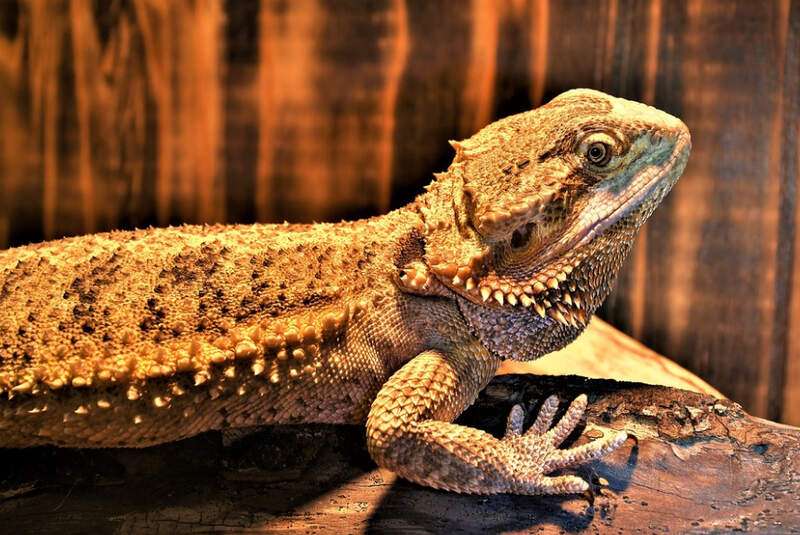
|
Scientific Name |
Pogona vitticeps |
|
Size |
60 cm (24 in) |
|
Life span |
10–15 years |
|
Location |
Eastern and central Australia |
|
Diet |
insects, lizards, small rodents, and plants. |
Central bearded dragons are a variety of agamid lizards found in a variety of arid and semi-arid regions.
Males have features such as a beard along with a wide head, a wide cloacal opening, a wider base of the tails, and the exceptional presence of hemipenes, which makes them distinguishable from females.
They are colored in various ways, such as brown, white, orange, yellow, etc.
Bearded dragons are so named due to the presence of beard-like guttural pouches on the bases of their necks and chins.
These lizards are undeniably mind-blowing, as they can change their coloration in moderation and do push-ups by lifting their bodies completely off the ground by using their powerful legs.
28) Australian Water Dragon
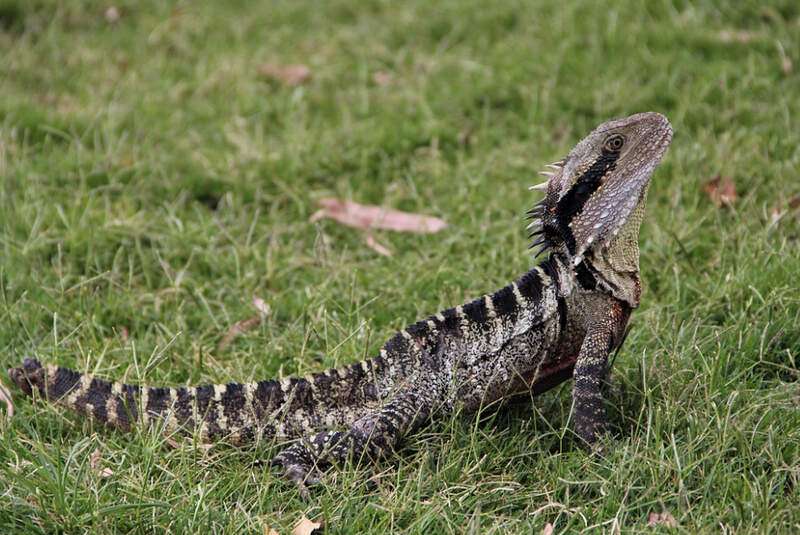
|
Scientific Name |
Intellagama lesueurii |
|
Size |
60 cm (2 feet) |
|
Life span |
20 years |
|
Location |
Eastern Australia |
|
Diet |
Plant matter, insects, and meat |
Australian water dragons are arboreal lizards that belong to the Agamid group of lizards. These lizards are very adaptable to cold and heat, which makes it easier for them to inhabit most southern coast areas in South Australia.
They are vividly colored in blue-green, which develops deeper hues during breeding seasons, and their overall appearance becomes quite notable.
They are quite large lizards that have elongated, strong legs and claws that aid them in climbing. Moreover, they have laterally compressed long tails that are sturdy and muscular and are used for swimming.
These lizards are docile but adapt to living in suburban parks and gardens in the presence of human populations with great agility.
27) San Esteban Chuckwalla
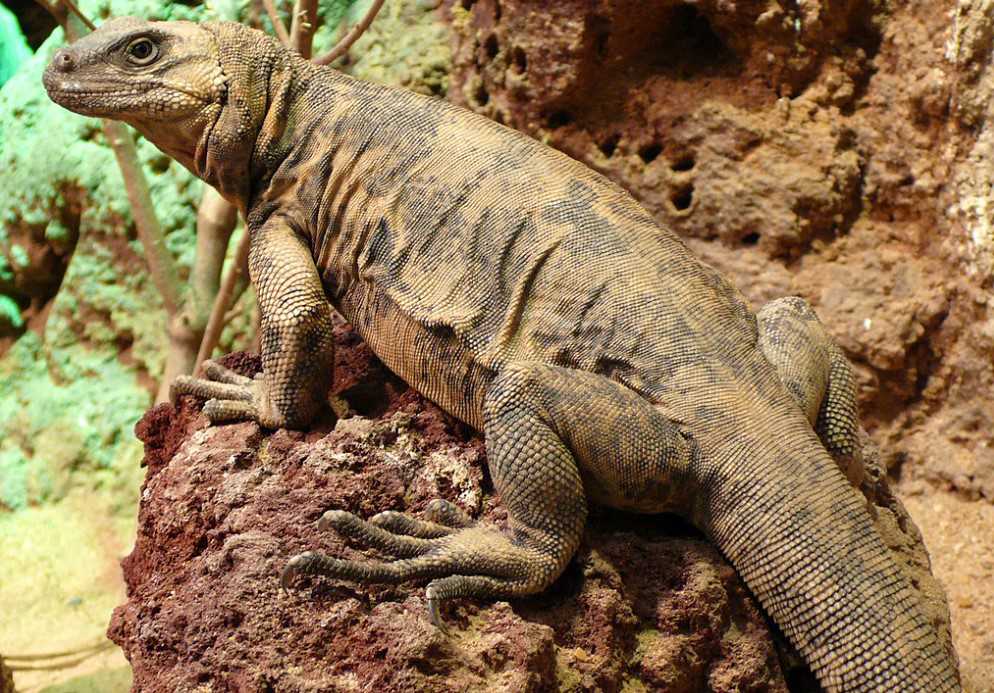
|
Scientific Name |
Sauromalus varius |
|
Size |
61 cm (24 in) |
|
Life span |
25 years |
|
Location |
San Esteban Island |
|
Diet |
cacti, leaves, fruits, flowers, weeds, and very rarely insects. |
San Esteban Chuckwallas are the largest species of all the extant chuckwallas, which are also known as pinto chuckwallas or piebald chuckwallas.
When threatened, these lizards gulp significant amounts of air and puff themselves up to entrench themselves by wedging into tight rock crevices.
They are quite muscular and heavy, may weigh up to 1.4 kg, and are three to four times bigger than their other common existing variants.
These lizards are colored so as to have perfect camouflage against predators and are colored gray, coupled with beige or tan patches, and have black heads.
26) Spiny-tailed Monitor
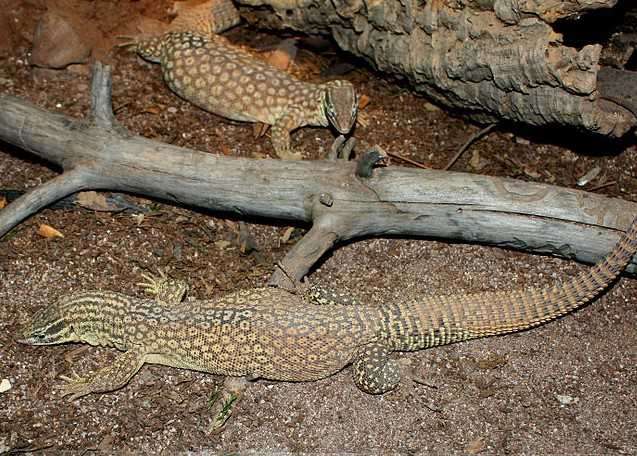
|
Scientific Name |
Varanus acanthurus |
|
Size |
70 cm (27 in) |
|
Life span |
10–15 years |
|
Location |
Northern Western Australia |
|
Diet |
arthropods, such as beetles, grasshoppers, cockroaches, spiders, snails, and crickets, as well as small lizards such as skinks and geckos. |
Spiny-tailed Monitor lizards are a type of monitor lizard, but they are smaller than the rest of their counterparts.
They have a very long tail that is almost 1.5–2.5 times bigger in comparison to the rest of their bodies. These lizards are brilliantly colored, with different types of patterns and textures in bold colors, and have patches and markings on their dorsum.
Dorsums are generally brown with lighter cream and yellow spots outlined by darker black markings and a few dark scales.
They inhabit arid regions with rocky fields and outcrops. Moreover, these lizards are quite shy and love to roam alone on grounds in their own company.
25) Solomon Islands Skink

|
Scientific Name |
Corucia zebrata |
|
Size |
81 cm (32 in) |
|
Life span |
25–30 years |
|
Location |
Solomon Islands |
|
Diet |
Leaves, fruits, flowers, and shoots |
Solomon Islands Skinks are also commonly known as prehensile-tailed skinks, which are arboreal and the largest known species of all the living skinks around the world.
These are very dangerous in terms of being protective of their families and defending their territories aggressively, and both sexes are territorial.
These lizards have slender builds and elongated bodies along with short, sturdy legs; moreover, they bear a large, triangular-shaped head embedded with a powerful crushing jaw.
They have a monkey-like prehensile tail, which is used for moving through branches like monkeys, along with thick, long, curved nails for grasping or climbing branches easily.
They are dark green lizards speckled with dark brown or pale black blotches.
These lizards are similar to snakes in that they smell through their tongues by flicking and gathering scents.
24) Chinese Water Dragon
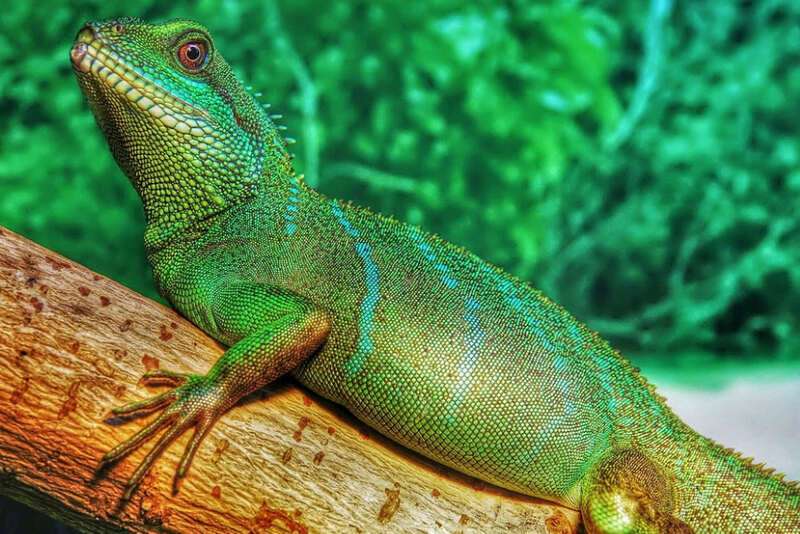
|
Scientific Name |
Physignathus cocincinus |
|
Size |
90 cm (36 in) |
|
Life span |
10–15 years |
|
Location |
China |
|
Diet |
Primarily insects and occasionally small reptiles, fish, mammals, birds, and birds’ eggs |
Chinese Water Dragons also have other common names such as Asian Water Dragons or Thai Water Dragons, which have an inflamed jaw like dragons.
These lizards are quite big and heavy and have bold colors such as shades of green and purple along with orange-colored bellies.
Their body is covered in diagonal stripes of turquoise green color, and their tails have a banded appearance with bands in green and white colors.
Not only are males bigger than females and have bigger crests, but they also have broader triangular heads. They are arboreal, diurnal, and social reptiles that love to live in groups.
Lastly, I want to mention that they have powerful tails that aid them in balancing and can be used as weapons, and along with that, their long tails also assist them in swimming.
23) Frilled Lizard
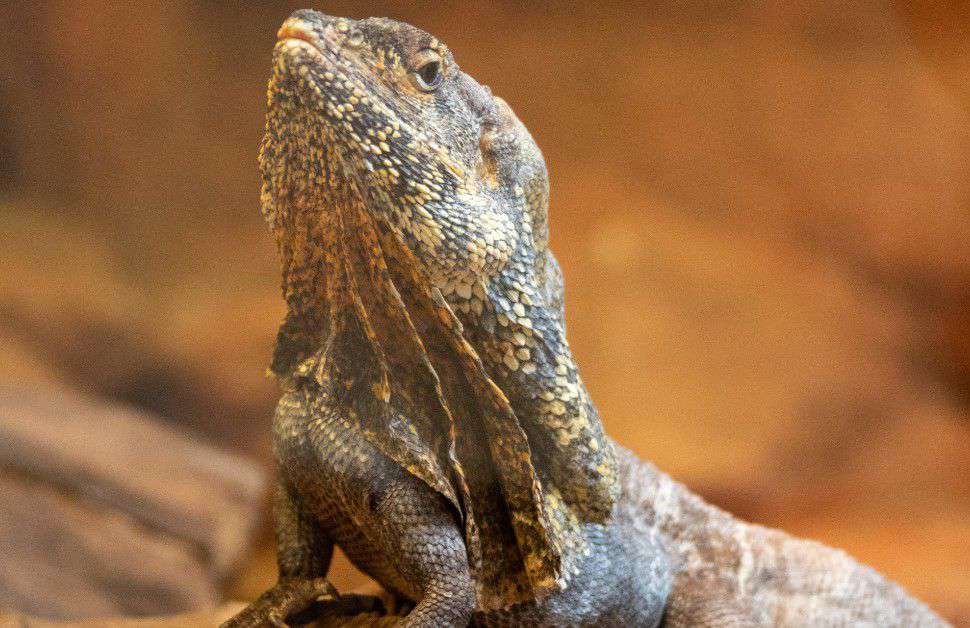
|
Scientific Name |
Chlamydosaurus kingii |
|
Size |
90 cm (35 in) |
|
Life span |
Up to 20 years |
|
Location |
Northern Australia, and southern New Guinea. |
|
Diet |
insects and other invertebrates, such as ants, termites, and centipedes. |
Frilled lizards are commonly called so due to the presence of a large, expansive frill encircling their necks, which generally stays folded and appears to be disc-shaped when opened, and they serve the primary function of displaying threats other than that used for communication among individuals.
It is also estimated that these frills could aid in hearing sounds by acting as directional microphones. To accommodate these large frills, they have long necks and torsos, as well as long bodies and tails.
They are solitary creatures that inhabit tropical forests and woodlands and have a unique ability to stand up and run using their hind limbs.
22) Savannah Monitor
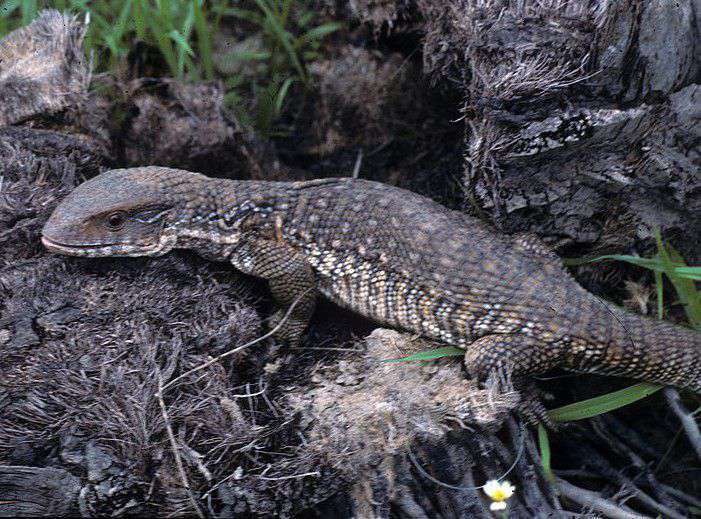
|
Scientific Name |
Varanus exanthematicus |
|
Size |
100 cm |
|
Life span |
17 years |
|
Location |
Africa |
|
Diet |
Invertebrates, such as millipedes, centipedes, scorpions, lepidopterans, beetles, mantids, snails, crabs, etc. |
Savannah monitors are diurnal terrestrial lizards that live in burrows and are quite solitary. They have great agility and planning skills and are colored with tan, gray, or yellowish markings.
Moreover,they are mostly domesticated lizards, but they grow very large. They are large and tough, with potent jaws and limbs, and they clinch their teeth.
Their body pattern varies according to the environment they live in. They are very similar to white-throated monitors. The average clutch size consists of 10–50 eggs.
21) Black Tree Monitor
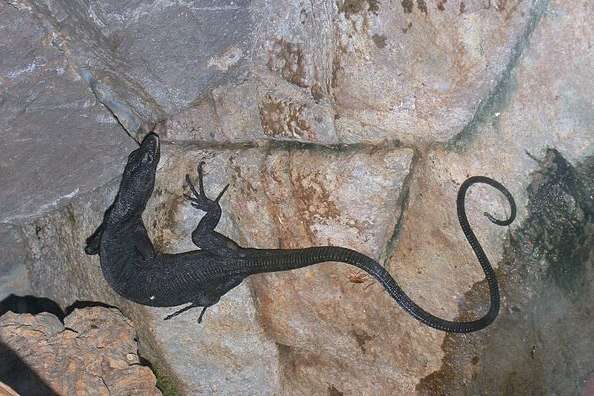
|
Scientific Name |
Varanus beccarii |
|
Size |
90–120 cm (35–47 in) |
|
Life span |
10-15 years |
|
Location |
Aru Islands in New Guinea |
|
Diet |
insects, lizards, and small mammals, along with eggs and nestlings of birds. |
Black tree monitors are comparatively smaller than other species of monitor lizards, as monitor lizards are one of the biggest living lizards on earth, but they are big enough to be on this list.
They are arboreal lizards that have dark black coloration and may develop deep blue coloration during breeding seasons.
These lizards are known to be found in mangrove swamps and to dwell on trees in humid forests, as they are highly arboreal.
The juveniles and young specimens have bright color speckles in yellow-green on a dark grey base, but the colorations deepen as they mature and become completely black.
Their prehensile tails serve the purpose of balancing and gripping trees to catch prey rather than using them in defensive tail-lashing behaviours as their other common counterparts do.
20) Rhinoceros iguana

|
Scientific Name |
Cyclura cornuta |
|
Size |
60–136 cm(24–54 in) |
|
Life span |
16-17 years. |
|
Location |
The Caribbean island of Hispaniola |
|
Diet |
Plant matter from a variety of plants, such as leaves, fruits, flowers, and berries |
Rhinoceros iguanas are large lizards that have shown a range of coloration from dark brown to steel grey to green and got their name from the presence of bony-plated horn-like tubercules or outgrowths, which are basically a pseudo-horn present on their snout.
They have a ponderous head along with sturdy legs and a heavy tail that is vertically flattened.
A dorsal crest of pointed scales is also present. These are shy creatures and flee away if threatened or attacked.
19) Black Spiny Tailed Iguana
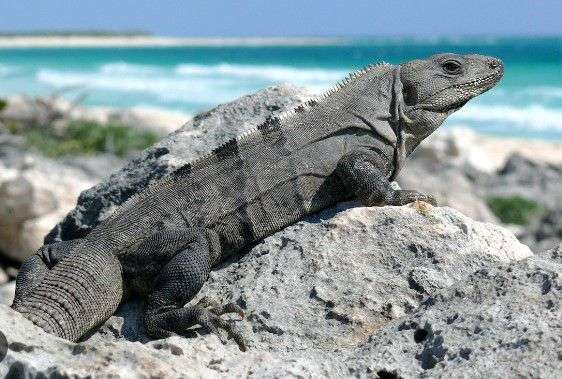
|
Scientific Name |
Ctenosaura similis |
|
Size |
130 cm (4 ft 3 in) |
|
Life span |
more than 60 years. |
|
Location |
Central America and Mexico |
|
Diet |
Plant matter, such as leaves, fruits, flowers, and stems Occasionally, they feed on arthropods, small animals, and their eggs. |
Spiny-tailed Iguanas are other big-sized lizards, which are more commonly known as western spiny-tailed iguanas or black spiny-tailed iguanas.
They are very social lizards in contrast to other species of Ctenosaura, as they are docile and solitary lizards. These lizards are greyish brown with yellowish bellies and have distinctive keeled scales on their dorsum.
As these lizards are skilled climbers, they prefer a rocky habitat with plenty of deep crevices where they can hide or sit to bask. They don’t mind trees in their surroundings, and they occasionally climb up on trees too.
Their ability to move fast helps them escape from predators, but when danger approaches, they use tail-lashing and biting behaviours on their predators.
18) European Legless Lizards
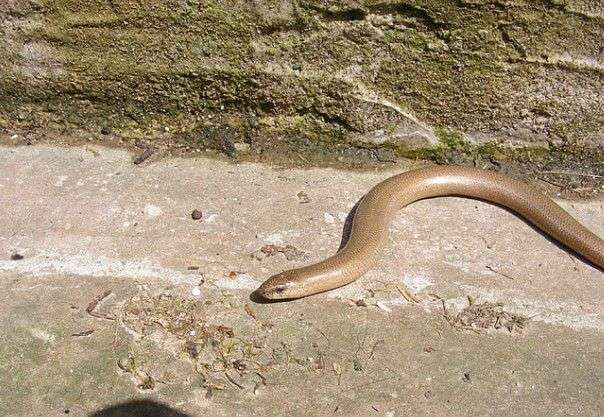
|
Scientific Name |
Pseudopus apodus |
|
Size |
135 cm (4.43 ft) |
|
Life span |
Up to 20 years |
|
Location |
southern Europe to Central Asia. |
|
Diet |
insects and small rodents, especially pinky mice. |
European legless lizards, or Pallas’s glass lizards, are the biggest legless glass lizards and are found inhabiting areas of sparsely wooded hills and compact grasslands.
They are quite big lizards that have tan or beige-yellow colored upper sides and dull undersides.
It is important to mention that like the giant earthworms, they too have a similar ring-like segmented appearance, but they have a distinguishing lateral groove, which is a fold of skin that falls down from each side.
If they are threatened, they defend themselves by hissing, musking, and biting, and they rarely display caudal autotomy as a defensive behavior.
Though they look similar to snakes, they can be distinguished by the presence of ears, ventral scales, and eyelids.
17) Argentine Black and White Tegu
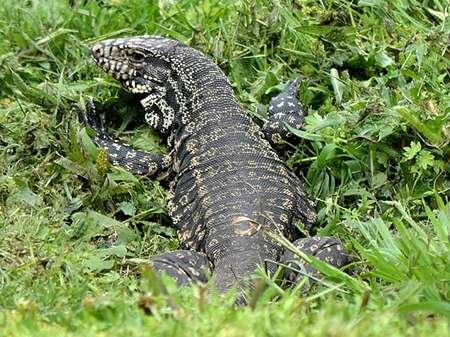
|
Scientific Name |
Salvator merianae |
|
Size |
91–140 cm (3–4.5 feet) |
|
Life span |
Up to 12 years |
|
Location |
Eastern and central South America |
|
Diet |
invertebrates, such as insects, spiders, crustaceans, annelids, etc., as well as fish, snakes, and small mammals. |
The Argentine black and white tegu, or simply the huge tegu, is also known as the Argentine giant tegu because this is the biggest of all the tegu lizard species present in the world. It is quite heavy and muscular and weighs around 2.5–7.0 kg.
Argentine giant tegus are very large and have a heavily built skull. They are colored emerald green and black at a young age and have a banding pattern on their tails in yellow and black; as they age, they become darker, and fewer solid bands show that the individual is older.
These reptiles are excellent runners and can run at great speeds. They are known to show different kinds of displays to look more threatening.
Such as running bipedally along with widely opening their front legs and broadening their mouth to show territorial defense. These lizards also use tail-lashing methods to attack predators and can do a lot of damage with one swipe.
16) Marine Iguana
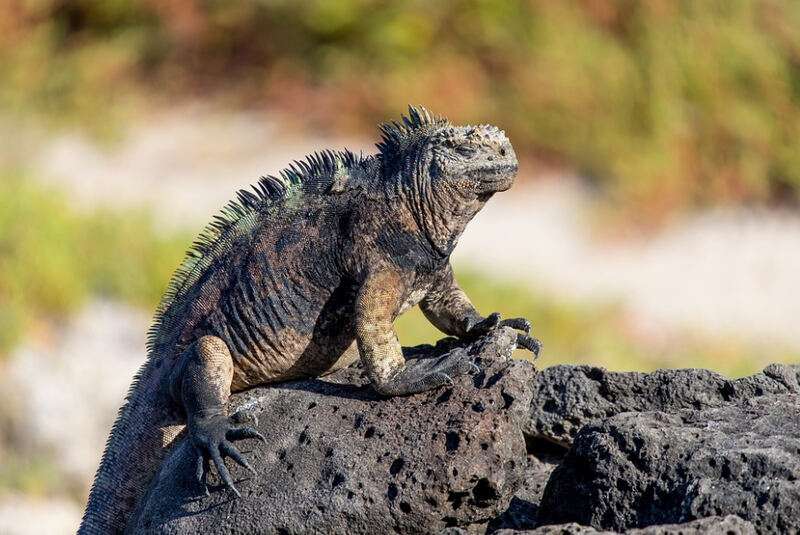
|
Scientific Name |
Amblyrhynchus cristatus |
|
Size |
60-140 cm (2–4.3 ft) |
|
Life span |
Up to 60 years |
|
Location |
Galapagos Islands(Ecuador) |
|
Diet |
red and green algae as well as small invertebrates. |
Marine iguanas, or sea iguanas, are fascinating and unique lizards as they are modern marine reptiles and have the capability to forage on sea algae.
These are the only lizards that dwell in marine environments and live and bask on rocky shores in colonies after travelling through cold waters, beaches, swamps, or marshes. These iguanas are sturdy and ponderous and have short, muscular limbs.
Adult male specimens have a row of spines descending from their nape to their back and extending down on their tails; moreover, their scales are sharp and conical.
Mostly black, some young and older specimens are grayish with lighter-colored stripes on their backs, and beside their normal coloration, during breeding time males develop intense red colored splotches.
15) Rock Monitor
|
Scientific Name |
Varanus albigularis |
|
Size |
85–150 cm (2.9–4.11 ft) |
|
Life span |
5–10 years. |
|
Location |
Central Africa |
|
Diet |
millipedes, molluscs, beetles, lizards, amphibians, snakes, tortoises, small mammals, and their eggs. |
Rock monitors are diurnal arboreal lizards that like to live in solitude in their burrows. Rock monitors are the second-longest living lizards in South Africa and the heaviest of all the lizards found on the respective continent.
They are called leguaan or likkewaan in the local language They have a sturdy appearance, and the length of their head and neck are almost the same.
A blue or pink-colored forked tongue is present, along with a bulbous but box-like snout.
Moreover, in terms of appearance, they appear to be muddy and have a grayish-brown mottled dorsum with white specks or spots. They may appear banded.
14) Blue Iguana
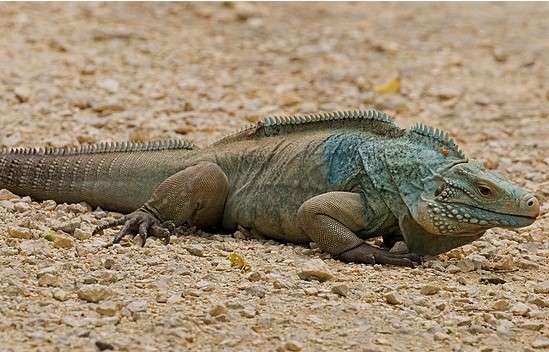
|
Scientific Name |
Cyclura lewisi |
|
Size |
150 cm (5 ft) |
|
Life span |
25–40 years |
|
Location |
Island of Grand Cayman |
|
Diet |
Plant matter, such as leaves, stems, nuts, fruits, and flowers |
Blue Iguanas are an endangered species of lizard that have the longest lifespan of all living lizards and inhabit rocky, well-lit, open grounds in dry forests and banks of rivers.
Their coloration is grayish-tan, with females being dull blue to olive green and males being grayish-blue or turquoise blue; a more pronounced blue cast is seen during breeding seasons on males.
They are ponderous, and their weight can reach up to 14kg. Moreover, a striking feature about them is the presence of a dorsal crest of short conical spines that descends from their necks till the end part of their tails.
13) Galapagos Land Iguana

|
Scientific Name |
Conolophus subcristatus |
|
Size |
90–150 cm (3–5 ft) |
|
Life span |
Up to 50 years |
|
Location |
Galapagos Islands |
|
Diet |
insects, carrion, and centipedes. |
Galapagos Land Iguanas are terrestrial and diurnal species of lizards that are herbivorous and oviparous. They are solitary reptiles that live in burrows. They are quite big and have a beautiful golden-yellow coloration.
Additionally, they bask in the daytime by dwelling on volcanic rocks and conserve heat by sleeping in their burrows at night.
These lizards also have a symbiotic relationship with birds in their surrounding areas, which pick out ticks and other parasites from their backs for food.
Moreover, they inhabit the dry lowlands of tropical dry forests. The average clutch size consists of 2–20 eggs, which get laid in burrows.
12) Bengal Monitor
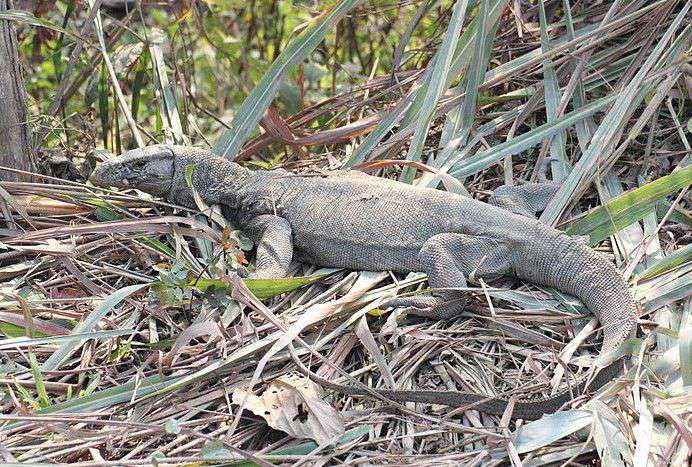
|
Scientific Name |
Varanus bengalensis |
|
Size |
61–175 cm (24–69 in) |
|
Life span |
22 years |
|
Location |
Southeast Asian and West Asian |
|
Diet |
Fish and aquatic insects, as well as frogs and toads |
Bengal monitors, more commonly known as Indian monitors, are one of the largest monitor lizards. They are arboreal at a young age but become terrestrial as they age and hunt and prey on the ground.
They are diurnal, solitary creatures that roam around, being nomadic, but live in their burrows at night. These lizards are yellowish-gray and have mottled or reticulated patterns on their backs in black color.
Youngs are more colorful than adults and possess dark crossbars on their neck, throat, and back along with yellow specks connected with dark transverse bars.
They inhabit desert and xeric shrublands as well as tropical savannas and moist forests.
11) Gray’s Monitor
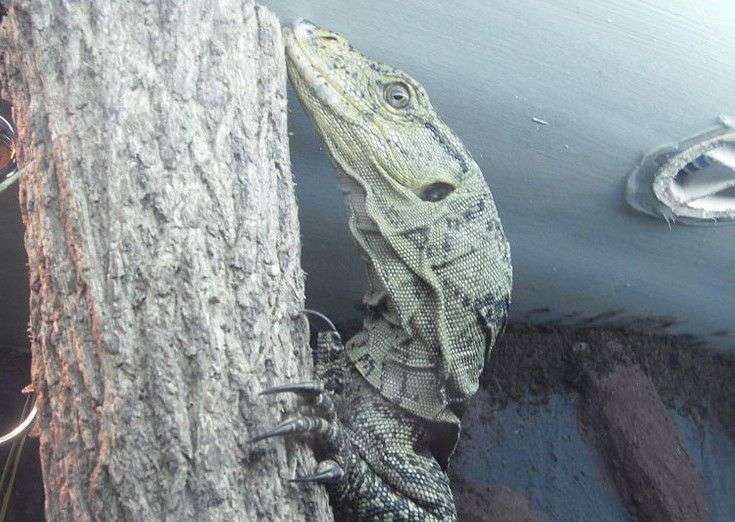
|
Scientific Name |
Varanus olivaceus |
|
Size |
152–180 cm (5.0–5.9 ft) |
|
Life span |
15 years |
|
Location |
Islands of the Philippines |
|
Diet |
Ripe fruits, beetles, snails, crabs, spiders, birds, and birds’ eggs |
Gray’s monitor lizards are one of the heaviest and biggest lizards and weigh more than 9 kg. They are extremely docile and largely arboreal.
They are sandy grey in color and have broad, dark bands of color on their backs that are directed randomly, and the thickness of the bands may also vary.
Moreover, black spots or small blotches are also scattered throughout their heavy bodies. They also have long, curved nails and elongated digits on hefty limbs. The average clutch size consists of 11 eggs.
10) Bennett’s long-tailed Monitor
Bennett's long-tailed monitor, 𝑽𝒂𝒓𝒂𝒏𝒖𝒔 𝒃𝒆𝒏𝒏𝒆𝒕𝒕𝒊 Weijola et al., 2020.
— Brian D. Greene (@thedeepgreene) April 24, 2021
Endemic to Palau; Yap & Losiep, FSM; and Sarigan, CNMI. A recent study suggests that they rafted to the islands during the late Pleistocene:https://t.co/Lw5qlMBXTK pic.twitter.com/Tx05HfyCnV
|
Scientific Name |
Varanus bennetti |
|
Size |
180 cm |
|
Life span |
up to 30 years. |
|
Location |
Palau, the Federated States of Micronesia, and the Northern Mariana Islands |
|
Diet |
Mostly polynesian rats, as well as insects and smaller lizards |
Bennett’s long-tailed monitor lizards are a type of monitor lizard that lives on trees but is mostly terrestrial in nature and takes refuge in burrows or under debris of foliage or vegetative matter on the ground.
They are large-sized monitors seen gripping on tree branches and have a completely dark black base with uniformly distributed bright yellow colored spots all over them.
They also have an orange hue on the bases of their beaks and the sides of their jaws.
9) White Throat Monitor

|
Scientific Name |
Varanus albigularis albigularis |
|
Size |
200 cm (6.6 ft) |
|
Life span |
12–20 years |
|
Location |
Southern Africa |
|
Diet |
Tortoises, beetles, molluscs, millipedes, and rodents |
White-throated monitors are quite popular pets for experienced pet owners because they are quite large and need a spacious area and favourable habitats to thrive in!
These lizards are quite playful and intelligent, and they lash out when threatened or to scare off their prey. They are grayish-brown or light brown with white bellies and mottled markings in yellow or white on their backs.
They are somewhat flattish, and their head and neck are flat. Besides their dark coloration, they have a dark-banded appearance. Moreover, they are aggressive towards other males and quite competitive.
8) Lace Monitor
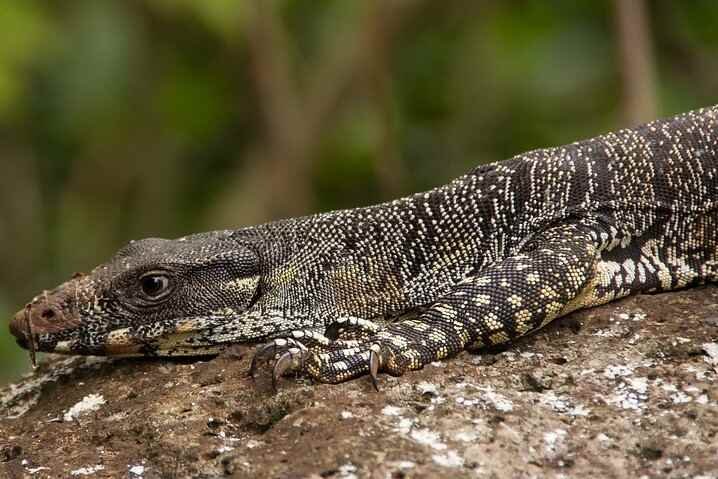
|
Scientific Name |
Varanus varius |
|
Size |
200 cm (6.6 ft) |
|
Life span |
up to 40 years. |
|
Location |
Eastern Australia |
|
Diet |
Carrions and meat of dead animals. |
Lace monitors are long and heavy lizards weighing up to 14kg that are the second-largest monitor lizards found in Australia, and males are generally bigger than females.
They have long, slender tails that become laterally flattened towards the tip and somewhat cylindrical at the base and are one and a half times longer than their heads and torsos.
It is stated that in the past these lizards could grow up to 8 feet, but now no species of this size exist. They could be colored brownish-tan or blueish-black with cream-colored specks all over.
7) Green Iguana

|
Scientific Name |
Iguana iguana |
|
Size |
170–200 cm (5.6–6.6 ft) |
|
Life span |
12–15 years |
|
Location |
Tropical parts of South America, Central America, and a few Eastern Caribbean Islands |
|
Diet |
Flowers, fruits, and leaves of trees and vines |
Despite their name, green iguanas can be found in a variety of colors, patterns, and types. They possess a line of spikes on their back and in their tail, which provide them protection from predators.
Their whipping tail has regeneration capacity, which means they can regenerate a new one. Green iguanas have good vision in bright light but poor vision in low light.
6) Black-throated Monitor
|
Scientific Name |
Varanus albigularis microstictus |
|
Size |
200 cm (7 ft) |
|
Life span |
more than 20 years. |
|
Location |
Tanzania |
|
Diet |
Freshwater mollusks, snakes, lizards, small birds, mice, rats, large roaches, crustaceans, fish, and eggs |
Black-throated monitor lizards are known to be large species of lizards; sometimes they grow up to the size of humans or longer than that. Their maximum height is 7 feet, and they weigh an average of 27 kilograms.
They are known to be as friendly and intelligent as dogs, which have hefty tails and muscular limbs with elongated claws; moreover, they have strong, powerful jaws.
They inhabit rocky outcrops, shrublands, woodlands, and arid savanna.
5) Nile Monitor

|
Scientific Name |
Varanus niloticus |
|
Size |
134–210 cm (4.5–5.7 ft) |
|
Life span |
up to 20 years. |
|
Location |
Sub-Saharan Africa and North America |
|
Diet |
Mostly frogs, toads, and fish, but occasionally they feed on small reptiles, rodents, birds, bird eggs, and other small mammals. |
Nile monitors are one of the world’s biggest living lizards and are considered to be Africa’s longest lizards; their tails are more than one metre long. Average length is between 4 feet and 7 feet.
Moreover, they are muscular and hefty creatures with influential jaws and strong legs. They are very courageous and ransack crocodile nests every now and then to rob their eggs in their absence.
They are skillfully adapted for an aquatic lifestyle because their nostrils are placed in such a manner that they can easily breathe underwater, too.
These big lizards are prey items for a martial eagle, which can carry and fly away with any individual weighing as much as 4 kg with ease.
4) Perentie
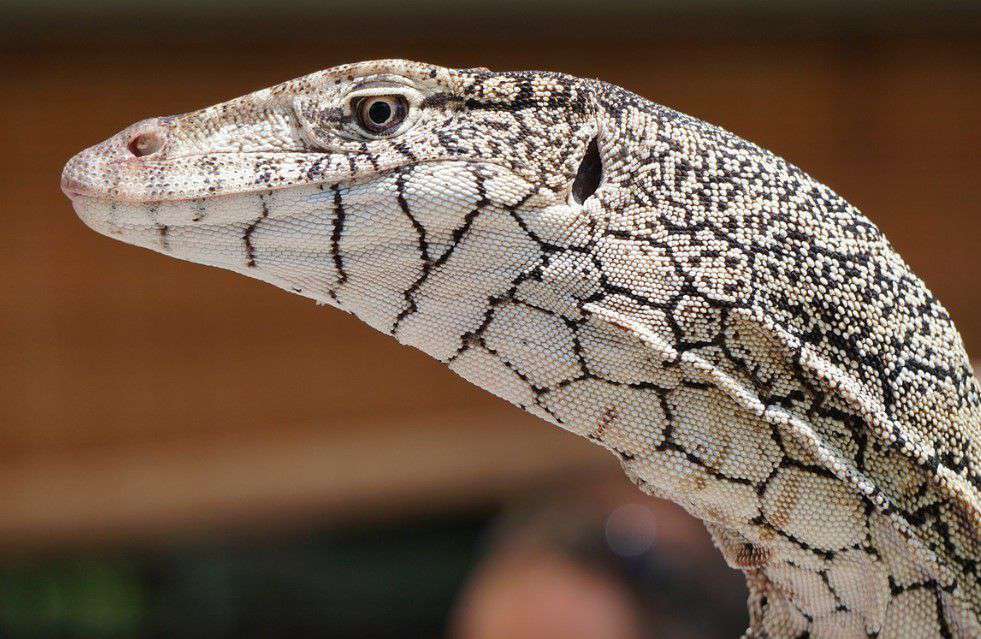
|
Scientific Name |
Varanus giganteus |
|
Size |
170–220 cm (5 ft 7 in to 6 ft 7 in) |
|
Life span |
20-30 years |
|
Location |
Australia |
|
Diet |
Reptiles, small mammals, and unique birds, such as diamond doves |
Perentie is one of the largest monitors that have striking eye-catching patterns in bold colors.
These lizards are rivals of the third-largest lizards, i.e., crocodile monitors, and can weigh more than 20 kg, but even then they are much leaner and less bulky than other monitors.
They are found in arid desert regions but are very difficult to see or capture, first because they are very docile, and second because they live remotely from human habitation.
It is ambiguous whether they are venomous, but they deliver infectious bites due to bacteria in their mouths, and mild envenomation may develop immediate effects such as pain, swelling, or blood clotting.
They are shy and avoid human contact, retreating even at the very least movements in their surroundings.
3) Crocodile Monitor

|
Scientific Name |
Varanus salvadorii |
|
Size |
48–244 cm (19–96 in) |
|
Life span |
10–20 years |
|
Location |
New Guinea |
|
Diet |
Frogs, reptiles, birds, bats, rodents, etc. |
Crocodile monitor is not a poisonous species of lizard, but sometimes it can be fatal if not taken care of. Their body is dark green with yellow spots, and they are the third largest lizard in the world and the largest lizard from New Guinea.
They have a distinctive blunt and bulbous snout just like crocodiles; hence, they are known as tree crocodiles. They are arboreal and inhabit coastal rainforests and mangrove swamps.
These lizards have greater running stamina than all monitor lizards. Teeth are sharp and straight, and one cannot sexually differentiate them by external features.
2) Asian Water Monitor
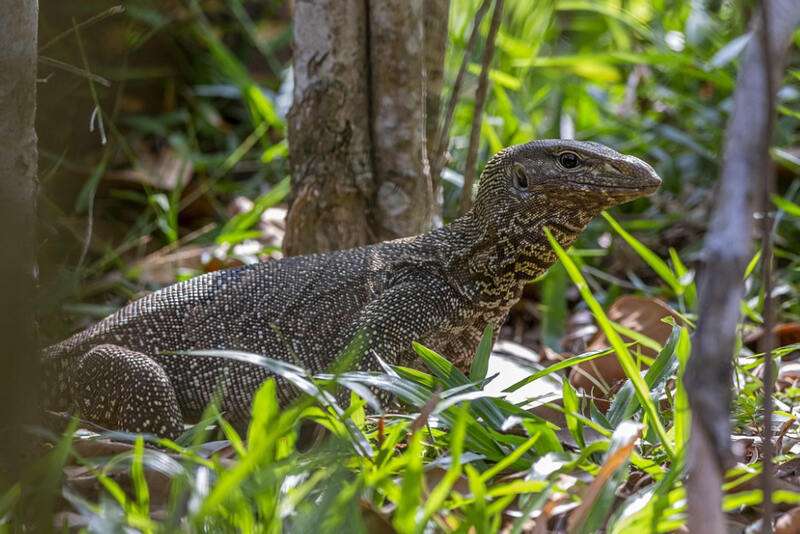
|
Scientific Name |
Varanus salvator |
|
Size |
150–250 cm (4 ft 11 in–6 ft 7 in) |
|
Life span |
11-25 years |
|
Location |
South and Southeast Asia |
|
Diet |
Fish, frogs, birds, crabs, rodents, turtles, young crocodiles, catfish, and the eggs of turtles and crocodiles, too. |
Asian water monitor lizards are the most common type of monitor found in Asia.
These are opportunistic lizards in terms of habitat and may be semi-aquatic or dwell in mangrove swamps or primary forests.
These lizards have immense abilities to defend themselves using their claws, jaws, and tails.
Water monitors can grow throughout their lifetime, and males are much larger than females, with an average weight of 30 kg, but there are some exceptional cases in which water monitors weigh approximately 90 kg. They are the world’s heaviest lizards.
These lizards are quite aggressive predators and are not even frightened of predators or humans; they hiss at them and use tail-lashing and tail-whipping behaviour at their predators to scare them.
Moreover, they can inflict several severe injuries through biting, so they should be handled with care and caution.
They are also well-adapted to human presence and may be found residing in agricultural fields and in canals in cities.
1) Komodo Dragon
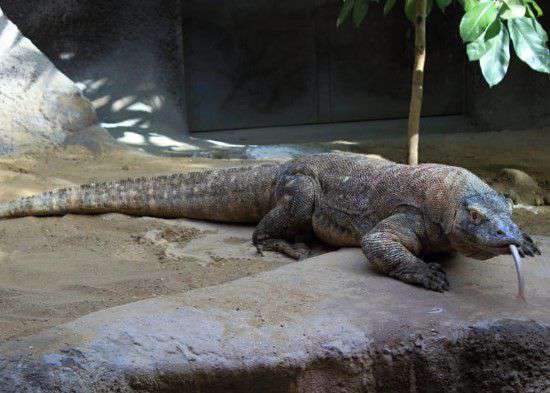
|
Scientific Name |
Varanus komodoensis |
|
Size |
229–259 cm (8.5–7.5 ft) |
|
Life span |
Up to 30 years |
|
Location |
Indonesian islands. |
|
Diet |
meats of rodents, deer, goats, pigs, and water buffaloes. |
Komodo dragons are popular for being the largest species of living lizards. They can attain a length of 10 feet and weigh as much as 70 kg.
As we can assume from their large size, they dominate the ecosystem that they live in, and therefore they live on their own islands. They are very dangerous, as they are known to be venomous and secrete several toxins that could function as anticoagulants.
There is a very high demand for them to be kept in zoos due to their big size and intimidating looks.
They love to dwell in dry and hot open areas of savannas, grasslands, and tropical forests.
The Komodo Dragons establish their dominance by standing on their hind legs and balancing on their tails.
Moreover, lastly, I want to mention that they have great smelling senses, and the ratio of their body and tail length is almost equal!
Conclusion:
We have seen that big lizards come with a variety of modifications and have special adaptations. Lizards have frills, horns, and wings, which serve different functions.
You might be surprised to know that even bigger lizards once existed on earth, and some species have recently gone extinct.
Surely, lizards are fascinating animals that trigger a variety of emotions in humans. Some are amazed by their advancement, while others creep out at the very thought of them. I hope you liked our post on the top 30 largest lizards in the world.
Also Read:

Hey there! I’ve been the kid who used to love watching all the science stuff and that fascination lead me to choose Zoology as my Major in Graduation. I’m a self-taught writer and spend my time writing scintillating content on animals. I love observing animals behavior and their bond with humans. I want to give my point of view regarding animals i research about. I had done several projects on animals during my graduation and learned their behavior thoroughly.
